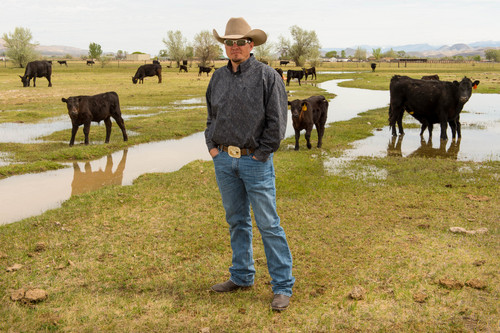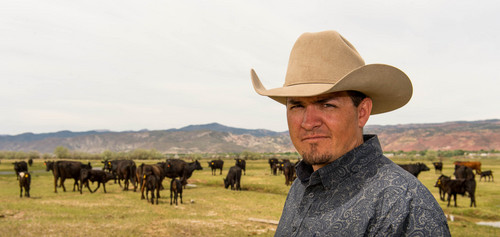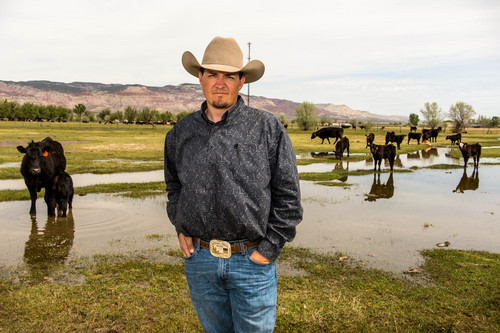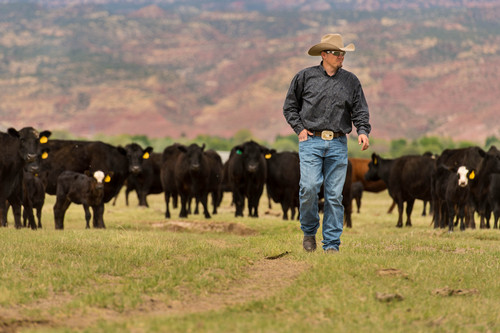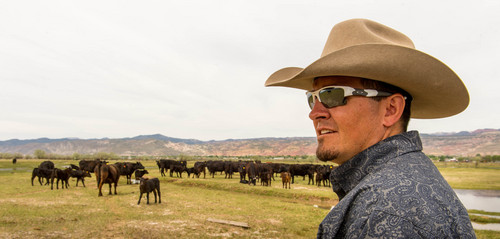This is an archived article that was published on sltrib.com in 2014, and information in the article may be outdated. It is provided only for personal research purposes and may not be reprinted.
Cameron Hallows runs cattle on private land on Monroe Mountain, a mosaic of open meadows and massive aspen stands once home to an elusive bull elk that still holds a world record for its massive antlers.
Elk, deer and other wildlife have shared the rangelands of the West with livestock for well over a century. But as drought continues and forage becomes scarce, ranchers' frustrations with a surging overpopulation of wild horses are spreading to big game.
Hallows was one of several ranchers who asked the Utah Wildlife Board earlier this month to encourage more hunting by increasing the number of permits issued.
"It is important we realize, us as livestock people, sportsmen, the Division [of Wildlife Resources] and everybody else, that we need to face the fact that there is a serious situation coming in our direction," Hallows, second vice president of the Utah Cattlemen's Association, told the board.
"If we don't get on the same page for range management," he warned, "it will affect us in a way we don't want it to."
Federal land managers acknowledge there are "too many mouths on the range" and say changing public values will likely play a larger role in determining how many, and which, animals roam and graze on public lands in the future.
"If the conditions are good then it is kind of like a large smorgasbord; there is enough food at the table and everybody is happy," said Eric Thacker, range extension specialist for the College of Natural Resources at Utah State University.
"Then, when we have a drought year, it becomes a big balancing act," he said, "with wildlife owned by the state using habitat owned by the federal agencies and leased to livestock interests."
The National Weather Service announced last week that drought conditions will "persist or intensify" over most of Utah through August.
—
'Strike a balance' • Like wild horses, elk in Utah exceed population goals.
Wildlife officials estimate there are 81,000 statewide, 1,000 more than the objective in the state elk management plan approved by the wildlife board in March 2010. At that time, the population was estimated at 68,000.
"Over the course of time, particularly in the state of Utah, there has been an evolution of a growing elk herd in our cattle-allotment country," said Terry Padilla, Intermountain Region range director in Ogden for the U.S. Forest Service.
The Forest Service and the Bureau of Land Management (BLM) manage livestock populations on nearly all federal lands in Utah.
"We need to strike a balance between the elk and cattle," Padilla said.
But the state's management plan, "as we read it with a fine-tooth comb, does not say in there that decisions must incorporate livestock needs," Sterling Brown, with the Utah Farm Bureau Federation, told the board at the May 1 meeting.
Still, the Wildlife Resources Code of Utah charges the board with trying to balance wildlife needs with "the social and economic activities of man," Brown noted.
The management plan also says ranges where elk coexist with mule deer and livestock should be closely monitored to prevent overuse. The state wildlife agency is pushing to increase the mule deer population to 350,000 statewide; it's currently estimated at 333,000. Deer are considered less significant competitors with cattle.
Wildlife numbers need to decrease when ranchers are asked to reduce livestock numbers, Brown argued, as the BLM did recently to protect forage for wild horses.
"You need to significantly increase [hunting] permits to bring down elk numbers to match the trends of livestock," Brown said. "You are getting more than we are, frankly."
At a break, ranchers talked about the irony of the board's approval of a letter chiding the BLM for not reducing wild horse herds to the federal agency's population goals — while elk climb above the state's goals.
"If our elk get 200 to 300 over objective, we catch heat, and horses are so far over objective," board member John Bair said during board discussions. "If elk and deer ever got that high, we would never come out in public."
—
'This reaches beyond one lifestyle' • Other big game animals also compete with livestock in Utah, and wildlife numbers are considered when the Forest Service and the BLM decide allotments for cattle grazing on public lands, Padilla said.
Competition between livestock and wildlife is magnified by drought and accentuated in certain areas — including Monroe Mountain, he said.
"On that range one of the key habitat species is aspen. In fact, one of the oldest aspen clones in the world," Padilla said. "We have reached a threshold of high grazing with all those aspen suckers and it is impeding aspen management objectives" to increase the number of trees.
Cattle can be controlled through regulating grazing, but elk are not easily rounded up and moved to greener pastures.
"Any number of elk tags can be issued, but these are migratory elk and they adapt to [hunting] pressure," Padilla said.
Wildlife board members make the same point.
Federal officials "just say, 'Hey, take X number of animals or a percent off,' but it is not that easy with wildlife," member Calvin Crandall said at the May meeting.
"I'm not saying we do what they used to do to jackrabbits — surround them and hit them with bats," he said. "But if we don't do something in the long run, wildlife will suffer."
Hunting restrictions help develop trophy animals, which in turn spur interest in hunting and raise funds for the state wildlife agency through licenses and permits.
Troy Justensen, vice president of Sportsmen for Fish and Wildlife, reminded the board that sportsmen have helped improve forage across the state, benefiting both wildlife and livestock.
"This reaches beyond one lifestyle. It is about all men, not just cattlemen," Justensen said. "If there are things we can do to benefit them, I'm for them, but we have done our part to try and raise the forage and support the animals we love to chase and admire."
—
'Shifting values' in the new West • The wildlife board increased hunting permits on the most drought-stricken hunting unit in southwestern Utah, and agreed to watch the range as summer progresses and increase elk tags in trouble areas.
The Forest Service is preparing to evaluate range in the state, and will hold public meetings to discuss how to cope with "too many mouths on the range," Padilla said.
He expects to hear from a growing number of people not directly connected to either livestock or hunting.
"There is a shifting balance in public values in the new West," Padilla said. "Our resource management is trying to strike a balance for all interests."
To find the best solutions, Thacker suggests a model that cattle interests are already familiar with: the sage grouse local working groups spread across the Great Basin.
The groups examine the realities of sage grouse conservation and possible impacts on rural communities. The key, Thacker said, is for interest groups to focus on one goal.
"Their overall goal was to keep the bird from being listed on the Endangered Species List," Thacker said. "Range working groups would also need to come up with a main goal, and it would likely be creating the best possible range in any given situation."
Hallows is hopeful stakeholders can work together.
"It's like having children: You have so many mouths to feed and you have to figure out how to do it," he said.
"If the range can't handle it, you have to figure out other options and all of them are expensive," he said. "I want my kids to be able to hunt elk and run cows. I'm scared to death right now they won't be able to do both. We have got to get this together."
Twitter: @BrettPrettyman —
Q & A: Grazing on public lands
To learn more about how grazing fees are set and related issues, visit http://bit.ly/1t6XB4i.


